Send any questions or comments to the designer Roger Caffin
The tents I have described here have been for sale, but at present I have ceased production as it wasn't economic. However, things may change.
They involve precision designs and superb materials, but if you want to treat them brutally they will suffer damage, and fail at an embarrassing time. (So what's new?) I accept no responsibility for what you make or what you do with them. Treat them with care, erect them with care, and maintain them with care, and I believe they should last a long time.

I have a couple of designs which may be used in summer, depending on how sheltered an environment is available. The lightest design with two poles is shown here in several stages of development. All these versions have been tested on many trips over the years as the design evolved. The V1 prototype shown first (left) was made out of cheap 'showerproof' nylon cloth I bought at a local fabric shop. Despite the poor nature of the acrylic coating, the tent survived several severe storms without leaking. I think the steep roof angle helped. However, the novel doorway was a bit of a problem in bad weather and the little vents were not perfect. (Actually, they weren't very good at all.) The V2 prototype shown next at night deep in Wollemi rainforest went some way towards solving the doorway and material problems, but turned out to be slightly too small in the vestibules for our liking and a bit too fiddly in some manufacturing details. The fabric was a crinkly spinnaker fabric and the tent made "a bit of noise" in the wind. Well, the noise was rather cute in a sort of way. Most of these problems were fixed in V4, shown to the right, pitched at home. The remaining 'defects' in my eyes were that the rear vestibule was still too small and the headroom was still not as good as I thought might be possible. The small rear end is shown in the picture to the left, deep in the rainforest of Wollemi NP.
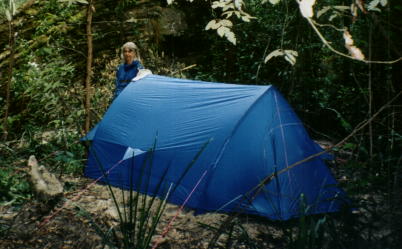
The poles on all these designs come to a point at the top, a little like an old A-frame tent. In fact, the whole design path started (many years ago) with an old Paddy Pallin A-frame japara (cotton) tent. The ridge line carries a seam, which adds strength along the top. Having a point at the top means there is no chance of heavy rain causing the middle of the roof to collect water and sag down. This is a problem with so many tents which have essentially flat tops. A pointy top also means the curvature required in the poles is gentle enough that straight Carbon fibre tubing (see below) can be used. Conventional aluminium poles may also be used, but they are heavier (although they can be pre-bent). However, the pointy design means a special elbow is required at the top of each pole. You can buy some elbows at a few angles from Easton, but I make mine from stainless steel tubing machined to fit inside the CF tubing and bent at the 'correct' angle. Evolving the bends and the equipment to make them at the precise angles has been an exercise in itself.
All the above prototypes worked, but they weren't good enough. I wanted more headroom, for no extra weight. I could get this by significantly increasing the amount of bend in the carbon fibre tubing, but that risked damage to the tubing when the safety limit was accidentally exceeded in the field. These things can happen when pitching the tent in bad weather. I did not want that risk. So I added two more bends to the pole design. The result at least looks 'different', but in fact has proven to be very robust and it sheds water extremely well. The room inside is wonderful. The slightly greater height out to the sides means a much larger amount of the floor space is 'sittable'. I built a V6 but it still had the poles in sleeves inside the roof. This made precise construction more difficult: not good for any volume production. But that's the problem with this game: you go through a lot of prototypes, and then have to store them somewhere! (To be honest, I sold most of the prototypes off cheaply to good homes.)

So I redesigned the whole pole sleeve system after a bit more testing, to put the poles in sleeves on the outside of the tent. Now I have been very critical of some tents which have great big sleeves on the outside of the inner tent, with the fly thrown over the lot. That's because the big sleeves allow the poles to move a lot, even to buckle, and the loose fly does nothing to restrain the poles. The guy ropes on those designs have no connection to the poles either, so they add little strength. The whole loose-fly pop-up-dome inner is simply not a good design for bad weather. (OK, if you are camping in the lowlands in fine weather it is probably just fine.) But in this case the external pole sleeve is very small, is attached to the fly, and the guy ropes are attached to the pole sleeves. The essential 'rigidity' is retained. So I was happy with the change in pole sleeve design.
Designing the panels for all these bends required some fairly heavy mathematics, but once I had the equations running for a single panel, adding more bends or more panels was fairly straightforward. You might wonder whether the bends are weak points, but the stainless steel tubing used for the bends is rather strong. However, other ways of doing this are possible - see below.
The current state of the art is the V8 tent, shown to the right. It is very similar to the V4 but has three bends in each pole to give increased headroom for negligable increase in weight, and the poles are in sleeves on the outside of the roof. The 'rear end' is usually slightly lower than the 'front end', more for appearance than anything else. Some early prototypes had only one large door at the front end, but the V8 has similar doors at both ends, with 'windows' at the top, and hoods over the windows to keep the rain out. The front end is big enough that I can sit across it inside while cooking: a very valuable feature in bad weather. The main door has two zips which allow the whole door to be opened up from the top down or from the bottom up. In the V2 picture the zips have been undone to the top and the door thrown over the right hand side, out of the way. This was often done in the evening when I was getting my gear into the tent. The V4 and V8 pictures show the door unzipped down to the ground, and this is now the more common approach. It is especially useful in the morning when I haven't got the reach from the inside to pass the door around the outside. The rear end has a similar door to allow packs to be put inside. They can be accessed from inside the tent during bad weather this way. The V8 design has better through-ventilation than the V4 design, to help control condensation on cold nights. However, there are still nights when some dew, for that is what it is, will happen no matter what. But I have noted the outside of the tent always has even more dew on it when it happens.
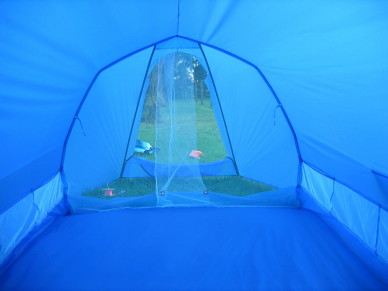
The tent is single-skinned, with mosquito netting internal doors and side walls. In the V1 and V2 pictures you can see white netting crumpled up across the front of the tent: the door in those models was sewn to the groundsheet. This arrangement was a bit messy and the door did get dirty and risked damage when it fell on the ground. The inner doors on later models consist of two overlapping panels of netting which hang down from the poles. You can tie them back to the poles to get them out of the way, or just let them hang down without anchoring the bottom edge. While they are free-hanging you can get in and out easily, but they stop insects from getting in. Finally, come the night-time, it is a matter of a couple of press-studs at the bottom to anchor them in position to the groundsheet. There is an overlap and a sealing flap at the middle to ensure insects really do not get in. It works very nicely. The netting side walls have pockets in them near the front door to hold things like glasses - things which you don't want to accidentally sit on in the night.
The various versions of this design have been on many trips over the years. the design has quite enough room for two people to sit up, eat, change and cook inside, even in a torrential downpour. The groundsheet has a huge side-wall around it: 150 mm high. The overlap between this and the roof edge blocks most everything. The silnylon fabric used is especially good for these tents it is effectively completely waterproof. I have even used this tent in the Snowy Mountains once, but this was pushing the limits very severely. We were lucky with the weather, and I won't do it again.
The space available is quite different from most of the American tarp tent designs, which tend to look more like glorified bivy bags, designed only for lying down in. The amusing bit (for me) is that the extra weight needed to give me all that space is really not very large. One of these tents is lighter than two bivy bags and a large tarp, and a damn sight more comfortable. The design is able to completely exclude rain and insects, and will handle some wind as well. It has been designed to allow a reasonable amount of air flow through it, from the window and the gap at ground level at the rear end and along the sides up to the window at the front end. The windows (at the top of the doors) can be made as large or as small as you wish, to control the amount of ventilation. There is also a verandah or hood over the top of the windows to keep the rain out while the window is open. Note that the window does not overhang the groundsheet at all, so even if a few spots come in they will not get on the dry gear on the groundsheet. Domes which have the top of the door over the groundsheet seem a singularly stupid design to me.
The ventilation makes this a good summer tent. In cold weather you can get condensation on the inside of any tent, especially if you seal it up. In very cold weather some condensation inside (or even frost!) is almost inevitable, unless there is a nice breeze overnight. The silnylon material I use is no exception to this general rule, but being so water-repellent it is very easy to wipe it down in the morning with a small washer. In seriously bad weather it is possible to seal the rear window against driving wind and rain with a Velcro strip, but this does mean the condensation inside may become significant. I would not use this tent in the snow for three reasons: the generous ventilation would make the tent rather cold, if there was wind the snow flakes would blow right through the tent, and if a lot of snow falls the roof loading becomes seriously too much. For that you need a double-skin tent with more poles, like my winter design.
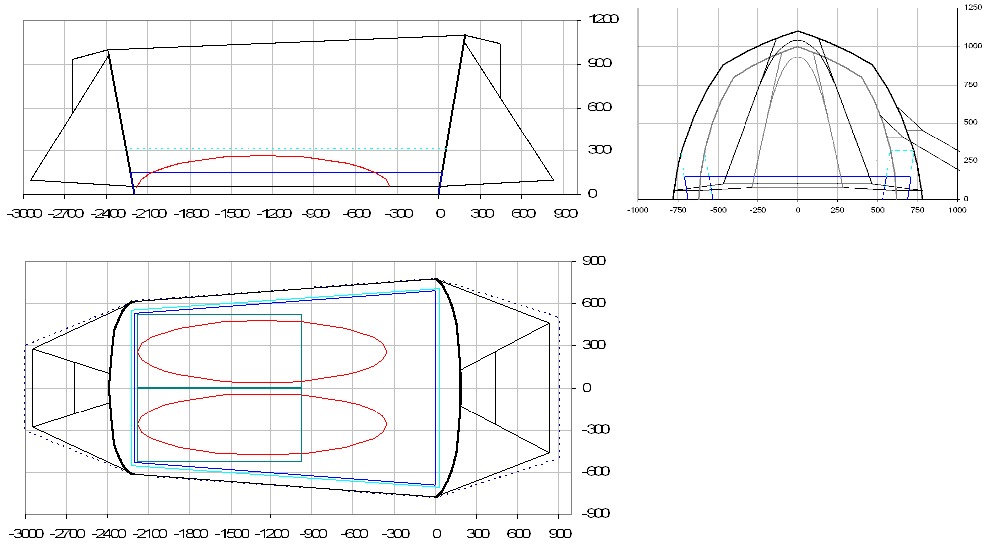
The diagram above shows a simplified plan of the current V8 version of the tent with two shaded mattresses and oval sleeping bags for scale. The groundsheet is shown as a dark blue line, but guy ropes have been simplified and only appear in the end view. I design these tents using mathematical descriptions of all the curves and a CAD system, which makes plotting out these diagrams quite easy. It is very easy to evolve the design on the screen this way too. The only problem is that the CAD systems can't open out the complex surfaces to make simple flat patterns: I have to plot those out myself.
The dotted line just outside the border in the top view shows the theoretical ground edge of the roof before a bit is effectively cut off the bottom edge to allow for ventilation. The later models, V4, V6 and V8, are not all that different overall, except that the V6 acquired extra bends in the poles to give greater headroom and V8 had the poles moved to the outside, as seen in the photos but not in the plan drawings.

A Queensland reader Sven had a go at making one of these designs, and his tent is shown here. He kept the front end as I had it and modified the rear end. The picture here shows the rear end. The dark line around the sides a little way above the ground is the top edge of the side mosquito netting walls. He used '3D Viper' CF arrow shafts for the poles, Easton aluminium arrow shafts for the straight joiners, and stock 10 mm aluminium tubing bought locally to make the bends. I think he found it necessary to use the right size tube bender to get good results. He found the ID of the 10 mm aluminium tubing slipped over the Viper shafts just nicely. Obviously it went over the outside of the CF tubing rather than inside (my stainless steel ones go on the inside). He looked at a thinner aluminium tube which could go inside the arrows, but was fairly sure it would not have been strong enough. That was my experience too. He rounded off the ends of the bent tubing so they would slide inside the sleeves without causing damage. His mosquito nets have zips on them at the front end, while I just overlap mine. The end result (tent, poles, bag) weighs 1116 g.
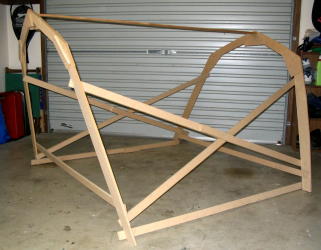
He experienced some condensation one humid night, and I suspect that the closed rear end may be responsible for this. I think you really need the air flow with this fabric as it is not a 'breathable' fabric - and some nights in Queendsland are just humid! His solution to this is extremely simple: he props up the middle of the back end at ground level with a short carbon fibre pole to make a much bigger inlet. Silnylon being rather elastic, it just absorbed the slight change in geometry.
He didn't have the full mathematical design system which I use, so he adopted another way of working out the shapes of the fabric panels for the rear end. First he made up the poles and arranged them to have about the right curvature. (This is a very smart approach!) While he was at it, he made all the bends exactly the same angle. (Mine are not all exactly the same, but most are pretty close.) Then he traced the pole curves onto some craftwood and cut the arches out. These would serve as templates for the planes of the poles. Then he erected the templates on the floor of his garage to look like the skeleton of the tent, ran string across all the corners, measured the key distances and draped the fabric over the templates. Now he could cut the panels out. You have only to look at the tent to see this worked. In addition, because he was not happy about sewing some of the seams where the whole tent would have to go through the machine, he used silicone sealant as an adhesive to make some of the lap joints. He reports that it took a while for the sealant to cure, but it worked. So DIY on large projects such as tents is very possible.
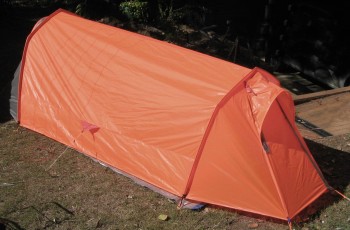
Another reader, Tom Hulse, took the plans for my 2-man 2-pole tent and copied them fairly closely. I think the zipper arrangement on the doors is slightly different, but the rest looks very familiar! Silnylon I believe. Tom managed to handle the bends in the poles just nicely. Then he went on to make another tent but to his own design: a one-man tent with full internal insect proofing.
What may be of interest is some of the engineering stuff Tom did. In the left-hand photo here we have a jig Tom made for machining connectors which had already been bent. I am sure you will need a live centre at the other end of the bend. I am also sure that getting this set up exactly right will take you more than a few minutes, but it is possible.

The second photo shows how Tom bent the tubing to make the bends: two formers and a press. I think you need the press to make the lower former, but if you have one - way to go. I use a tube bender instead, and a long lever.
The thrid photo sghows how Tom designed the pole feet. This is quite different from how i do it, which only goes to show that you don't have to follow my drawings that closely. The idea here is that the poles lock into the connecting plates: mine just go through grommets. To remiove the poles on toms you have to pull the pole foot sideways slightly.
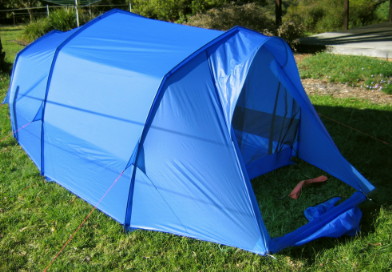
The two pole versions above are very good when you know you have some shelter. There have been a few times when the amount of shelter was not quite enough - up around Gungarten near Kosci one night sticks in my memory. It wasn't the wind itself that was the problem; it was the regular gusts of turbulence which slammed the tent in all four directions which caused some worry. Turbulence is like that: you never know which way it will strike next. Well, the two pole tent survived just fine, but only because I had pitched it very carefully. It occurred to me that a three pole version would be heavier by the small weight of one extra pole (just over 100 g), but it would be so much stronger. Halving the span of any beam makes huge improvements to its strength; the same applies here. So now I have a three pole version, as shown here.
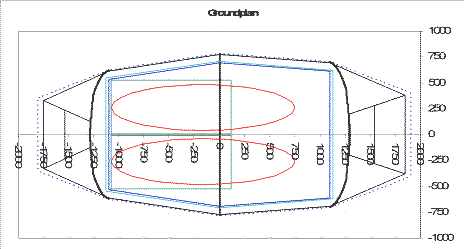
Apart from the improved resistance to storms, a lovely feature of this tent is the even greater amount of head room inside it. That is caused by the higher centre pole of course, However, I was careful to avoid making the front end much smaller because that's where the cook has to sit at dinner time. It would be quite possible to have the middle and front poles exactly the same size of course. In fact, a couple of Nordic tunnel tents have all three poles exactly the same size. But I wanted a slightly more elegant appearance: hence the slight taper.
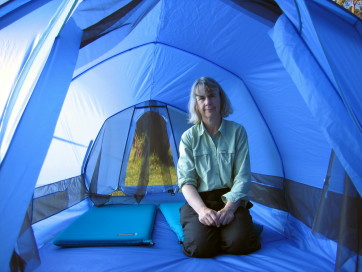
An astute observer will recognise that this 'summer' tent has an engineering structure very similar to that classic winter tent, the (old) Macpac Olympus. The only real difference is the acutely scalloped cut around the centre pole of the Olympus: I didn't go for that idea as it does not give any headroom payoff. However, the similarity means this tent has similar strength against the wind. But it isn't recommended for snow use as there is no inner tent. Snow could fly right through it. It's bad enough when you have snow flying through an Olympus between the inner and outer tent! Actually, it has been used in the snow when an autumn trip around Kosci copped somewhat worse weather than expected. It didn't like the combination of heavy snow loading on the roof and violent downwards gusts. You have been warned!
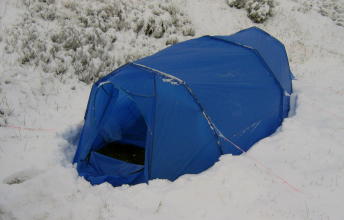
One key design improvement not shown in the pictures has been the addition of two end guys at each end. These go out in the lengthwise direction, and allow me to tension the roof far better than the bungee cords at ground level can ever do. One reason is that the end guys take a huge load off the bungee pegs at the end corners. Without the end guys these corner pegs have to hold a significant load to keep the roof tight, and the angle of pull is not good. The increased tension along the roof really adds to the stability of the tent under bad weather, and especially in snow. The cost is the weight of the extra pegs, but when you need the extra protection, four more pegs is a small price to pay. The extras are some of my 'camo' pegs, at only 4 grams each, so the weight penalty is miniscule. In the snow picture here we didn't have these extra guys, and their lack was noticeable. Few commercial tunnel tents have such end guys, but mostly they aren't designed for serious weather anyhow.
It is likely that this design will be my general all-purpose tent for most conditions. I may take the 2-pole version sometimes when I am very confident about the weather but the increased comfort of this one, plus the increased security, makes it very appealing. And the final weight of this one is only a little more. But it isn't a snow tent! Update: I eventually sold the 2-pole tent as I wasn't using it any more. The buyer was camping in more sheltered locations.
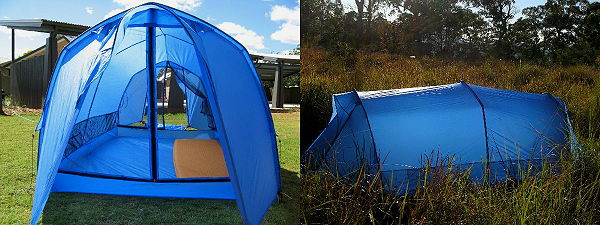
Greg Hansell had a go at copying my 2-man 3-Pole tent, and produced a version which looks astonishingly like mine. The only significant difference as far as I can see lies in the netting doors. He wrote back to me when it was finished, thus:
As I have already told you, the tent was altered to be symmetrical, with the larger vestibule at each end. Last update I gave you I was working on the poles, mainly the joiners. After much thought and discussion with people (including your comments) I disbanded the idea of using solid steel joiners that sleeved the inside of the carbon fibre poles. Initial attempts to bend the alloy tubing were not successful. In the end, filling the alloy poles with sand, bunging the ends tightly and bending over a large circumference cylinder resulted in satisfactory joiners. The angles were not precise, but after making the 9 joiners, I mixed and matched the sets of 3 so they were approximately even.After the tent was ‘finished’ I used it while doing a driving tour of northern/central NSW, mainly in National Parks. I found the mesh doors were far from satisfactory for keeping insects out. Having 10cm of overlap was not keeping insects out. The reason that zippers weren’t used in the first place was that sourcing suitable lightweight, non-locking zippers was practically impossible. Several months later, zips were found at a market. Not sure if the company that makes them is still in business (looks to be old stock), but the contact details for the distributor are/was: Valko, PO Box 615, Dee Why 2099
The zips have a steel single sided non-locking slider and plastic runners. Each pack had 150cm of zip fastener and 3 sliders. So that they can accessed from either inside the tent or outside, 1 tab is on the outside, with the remaining 2 facing inside (much like the zips on the vestibules - one in and one out - works very well!).
The final weighs for the tent are:
Tent – 1088g \ 1302 g
Poles – 214g /
Pegs – 214g (14 pegs in total)Not bad, especially considering that the tent is marginally bigger than yours, and I’m using steel pegs (but like you say on your website, the light gauge steel pegs aren’t much heavier than the expensive alternatives). Being slightly larger than your design though, I find it barely fits in the bottom compartment of your old pack. Instead of forcing it in, I tend to put it elsewhere in the pack.
Another difference from your design is the stiffening in the hoods. The proper name escapes me right now, but I believe it is called boning (used in wedding dresses and the like to give/keep shape). Works well, but does tend to hold bends from being packed up (which can usually be un-bent once the tent is up).
In fact Greg's tent only weighs a fraction more than mine. The netting zippers probably add some weight, but his poles are a little lighter. Replacing my stainless steel joiners with aluminium alloy ones may have something to do with that.
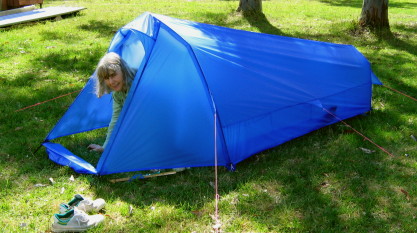
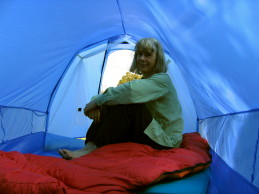
I was persuaded to consider a one-man version of my design as I was getting quite a few requests. Because the design is fully parametric (ie described mathematically), it was possible to adjust the parameters to get such a design quite simply. It has a lower and narrower rear end to reduce the weight, but a good front door and vestibule. The floor space ended up quite generous: this was a consequence of my keeping a good height at the front end for sitting up in. This SoloV1 tent weighs just 800 g with poles and sewn-in groundsheet.
Looking at the pictures here you can see that the pole arch has three bends. This was essential to give the interior enough room for someone to 'live' in the tent in bad weather. With only one bend at the top, the whole thing was far too narrow and simply not worth building.
With some one-man tents you feel that you are in some sort of a coffin. However, making a tent this small does not really save a lot of weight. Going from something really cramped to something this large must have added about 100 g to the overall weight, no more. The reason is that the silnylon fabric is so light. You end up with an interior which looks like the picture to the right. The foot end is wide enough for a Therm-a-Rest mat, and there is enough head room there that you could sleep with your feet at the main door if the ground was rather tilted.
Ventilation is even more important in a tent as small as this. There is a gap all around the base of the roof and a window at the top of the main door, and this will create a reasonable airflow. However, there is also a zip in the bell end at the rear which can be opened, and this is a wonderful improvement on hot evenings. One could put a hood and window there, but it would be rather small and fiddly!

I have also made 3-pole versions of this for solo walkers. Two of them are shown here. However, while the design is lighter than the equivalent 2-man tent, it is not 'half' the weight. One Man tents are not a really efficient design for weight. Also, they are by design lower than the 2-man versions, and you can't prevent this from happening with this design approach.
The blue one was made for summer Australian conditions, but the orange one was made for a fairly serious ultra-light walker in America for use in the winter, in the snow. It has a few extra tricks in its design to make it a bit more rugged, like a provision for double centre poles. Mind you, I reckon it could be a little drafty if pitched out on the open snow plains.
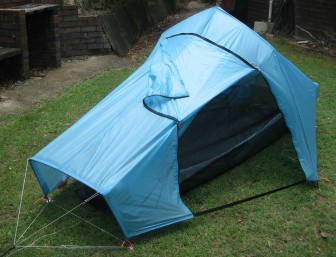
Once he had made one tent Tom Hulse apparently decided to make another, but this time it was a 1-man tent with 3 poles for robustness, plus an inner tent. The inner tent is visible: it has a nylon roof to deflect any drips from condensation, but the side walls are no-see-um netting. It's meant for Queensland conditions, and they have insects! The big middle pole has been 'borrowed' from his 2-man 2-pole tent. As you can see, the design here is quite different, with open ends for ventilation and a side-opening door. There is gear room under the fly, and cooking space there as well. You would need to be just a bit careful about the stove and the tent fly, and make sure there is enough ventilation for the stove fumes.
I should mention one caution with a tent of this design: it has been designed for warm weather, and would not be suitable for cold weather. Why? there are two reasons. The first and most obvious reason lies with the open ends. These are great in warm weather, but not so good when a cold wind is whistling around. The second is not so obvious until you have used a tent in cold weather. There is no ventilation right at the top ridge, and this means that condensation will form on the inside of the tent when the outside temperature drops far enough. But Tom did say it has been designed for Queensland conditions. A full winter tent might prove to be a bit stifling in Queensland.
Variations (prototypes) on my designs have been used successfully in good and bad weather, even in the Snowy Mountains. The first pale blue prototype weighed about 1.8 kg using materials I could find in local shops. They were fairly conventional, and too heavy. So I steadily refined all the materials as well as the designs. The V4 I had been using for several years weighed 1.260 kg complete with carbon fibre poles and tent-pole-tubing pegs, while the current V8 design comes in at almost exactly the same weight with poles but not the pegs. The V8 works out fractionally heavier than the V4, but that's because the rear end on the V4 was too small. You could not get anything in there, and that's where we like to store the packs overnight in bad weather.
The silnylon fabric has proved to be strong, the CF poles are strong, the Dyneema cord makes good guy ropes as long as you use the right toggles, and the shapes are fairly aerodynamic. They takes a fair bit of wind, with the 3 pole versions being substantially more robust than the 2 pole ones. However, if you try to pitch any of these on the crest of the Main Range when a 100 kph storm comes whistling up the Murray Valley, don't blame me if you have an 'interesting' (or catastrophic) night. It is always a wise move to seek a bit of shelter for your campsite, no matter what the tent. The same applies here.
I had better admit that the CF poles on the 3-pole tent have failed once. We were camped under a sharp bank in the Snowy Mountains one night (in Autumn), and there was a storm. A lot of snow got dumped on the tent since it was in the lee of this bank, and the wind coming over the bank made a lot of turbulence. About 3 am the wind got very bad and a vortex off the bank slammed the roof of the tent down to the ground. This made the middle poles bulge outwards to an astonishing degree, and they failed with a noise like mortar fire. It woke us up rather quickly ... The break was in the middle of the lower poles right at the joiner. A small amount had snapped off inside the joiner. However, we knocked the snow off the tent, pushed it back up to approximately the right shape, whereupon the bungee cord and the pole sleeves kept the tent together for the rest of the night. Repairs simply consisted of replacing the broken pole sections. But I have seen Easton poles snap under similar conditions! The moral here is to not camp right under the lee of a bank: severe turbulance happens! (You would think I should know by now!)
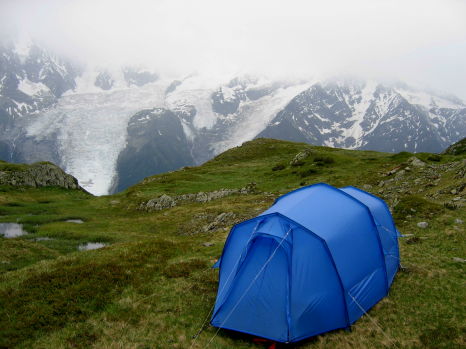
The 3-pole version went through France with us in 2008. We spent about 3 months camping in it, and some of the weather was not so pretty. The photo here shows us camped in a very exposed position right on the edge of the tops opposite Mont Blanc, above Chamonix. Yes it was a risky place to camp, and yes we had bad weather than night. But yes, we slept well and the tent coped nicely. Mind you, the guy ropes may have worked a little during the night. An addition we made to the design before going to France was to allow for an internal guy rope across the middle pole. It went across at the level of the bottom edge of the upper guy rope anchors, and effectively prevents the middle pole from bulging. The idea works very well.
Just what the tent weighs depends on the materials used in its construction. Some of the materials I am using are a little hard to find at your average shopping centre, but the DIY page should let you get it all. Yes, you can have a really comfortable two-man tent with sewn-in groundsheet and full insect proofing at a weight between 1.2 and 1.3 kg, including poles and pegs. One can be more aggressive in weight reduction, but you start losing space and ventilation. Anyhow, it is little different in weight from a 2-man tarp tent with a groundsheet, but a whole lot more comfortable imho.
The silnylon for the fly weighs about 49 gsm and is very waterproof (60+ kPa). I say 'about' because the weight can vary depending on the production run. There are few manufacturers of this fabric at present in the world, so you take what you can get. You can go lighter still with a local silicone spinnaker fabric at about 34 gsm: this is the material used in the V2 picture. There are a couple of sailmakers who can oblige. The V2 rattled a bit in the wind but worked fine in the rain during my early testing, but I cannot recommend it for serious use. My concern is that the crinkly coating may start to leak along creases after a time: some evidence of this has been seen in one of my tent stuff-bags. The problem is that the coating includes (I believe) polycarbonate as well as silicone, in order to get the stiffness that the spinnaker-makers want. The coating can crack or crumble a bit at the seams, and leak there. But since the makers of such fabrics regard all this information as utterly competitive stuff they won't give away much information.
You can go lighter with even lighter spinnaker fabrics from various companies, but they too are stiff and crinkly. I am not convinced. Finally, you can go even lighter still with some very exotic stuff made by an American company called Cuban Fiber. (They have no relation with Cuba.) Their fabric comes in various weights and goes down to appallingly low figures, but the price goes up very high to compensate! The fabric consists of two sheets of Mylar film laminated over a loose mesh of high tensile fibres (not threads), and once again was originally intended for spinnakers. However, one does hear about sailors bursting their Cuban spinnakers when the wind picks up. A very expensive accident I gather. The stuff is utterly non-stretch, which means you have to get the sewing absolutely right, down to the millimetre - except that sewing it makes holes in the Mylar and these holes grow under tension. You have to tape it. At this stage some extreme Americans are making super-ultra-light tarps out of it, but not tents. (We did consider making one, but were not convinced it would work.) We had thoughts about making UL packs with it, but in the end the same problems made most of us defer the idea. It is OK for a pack for a very UL load - a few kg maybe.
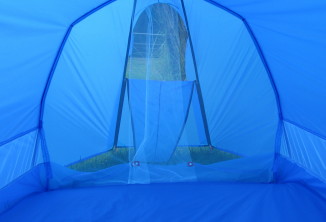
After comparing the weights of Easton aluminium tubing and carbon fibre (CF) tubing for similar strengths, it was obvious that CF was the way to go for UL tents. The problems of dealing with the Easton company didn't help of course (they aren't interested unless you want to spend thousands of dollars). However, that left me with three different forms of CF tubing, as discussed under poles in the 'standard' section. I went with a 5-layer radial wrap CF tube which is made in huge volume as arrow shafts. Considering the violence an arrow gets when it hits a target, it is clear that these have considerable strength. I describe some crush tests in the pole section as well. Anyhow, after several years in the field I have to report that these CF poles have taken almost everything I have thrown at them - and there were a couple of unplanned incidents along the way.
The bends are made from stainless steel tubing, machined to precisdely the right diameter to fit inside the CF tubing. Then the tube is bent in a special precision calibrated bender I made for the task: I can get a bend to about 1 degree accuracy this way. Straight joints between sections of CF tube are made with some Easton tubing which fits to a whisker over the outside of the CF tubing. However, Sven made his bends out of aluminium tubing which went over his CF poles. So clearly both methods work.
The imported Fibraplex carbon fibre poles used in the V2 picture weigh 26 g/m while the Bullet arrow tubing used in the later units weighs about 19 g/m. I made all the later assemblies myself. You have to add a little weight for the joiners and bends, pole feet and some string and bungee cord up the middle: that's how the little extras creep in. The bottom of the poles are inserted into tabs sticking out from the corners of the groundsheet. This arrangement is common, and it keeps the groundsheet stretched out and inside the roofline.
The mosquito-netting doors hang from the poles sleeves and go down to the groundsheet on the inside. They overlap in the middle with a baffle to really block the bugs. They can be pulled right back to the poles and tied there for a large entry. As the whole netting doorway overhangs at the top the bit of netting at the bottom leans against the inside of the groundsheet wall and seals quite effectively against it. There are also some press-studs near the middle on both halves of the doors: you can see little white spots in the pictures. I usually pile some gear against the bottom edge before going to sleep, just to be certain. There are netting sidewalls between the groundsheet and the roof as well. Both are seen in the picture to the right - the blue colour is due of course to the roof. I use 'mosquito netting' here in Australia, but it won't stop the dreaded Scottish midges or the equally noxious New Zealand sand flies. For that I substitute 'no-see-um' mesh, which has far smaller holes but weighs a little more. However, be careful what form you buy: some forms seem to block the airflow rather badly. It's a trade-off.
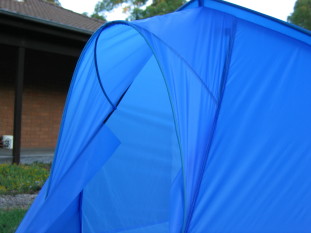
There is a storm hood over the window at the top of the door to keep rain from coming in. The V2 design was poor: it could be blown back. The V4 design was better because it couldn't be pushed or blown back very easily. The V8 design shown to the left uses two lengths of whippersnipper cord to brace the hood up. It does not get blown back unless you have the front door of the tent pointing into a howling gale, and it overhangs the top end of the external door quite a nice distance. This overhang lets you leave the window at the top of the external door open a long way in practice, and this really helps keep the ventilation up and the condensation down.
The inner netting door is tilted backwards from the peak so the the edge of the groundsheet is not under the window. This means that any rain getting through a window lands a long way from the groundsheet. I do not like those dome designs where the top of the door is way over the groundsheet: this doesn't work very well in the rain! It also means you can cheerfully cook inside the vestibule with air coming in at the ground level and exiting through the window above, even in very poor weather. I've done this for weeks on end in good and bad weather. The advantage of the whippersnipper cord in the hoods is that it can be rolled up when you pack the tent with no damage: it pops back up the next time you pitch the tent.
You may need to experiment a bit with the whipper-snipper cord. I use some which is about 3.3 mm diameter: quite thick. The thinner stuff won't span a large distance without buckling. Some of the buckling may be due to the way it is supplied - all coiled up. Perfection has not yet been achieved!
I like the roof or fly to come down fairly close to the ground but to be some distance out from the edge of the groundsheet. Even a 60 mm height at the bottom of the fly amounts to a lot of air space over its length. Less might make the tent a bit more storm-proof, but the ground is often a bit lumpy and I find that a smaller clearance sometimes puts bits of the edge of the fly on the ground. So 60 mm works for me.
I put a 150 mm wall around the groundsheet to keep stray water out: this sort of high wall has worked well even when the tent was 'floating' one time in about 10+ mm of sheet water during a Sydney storm. It can be slightly alarming to sit inside the groundsheet and see water surround you to a noticable depth. It's even more alarming when you realise that parts of the groundsheet are floating off the ground! : it makes you wonder about your choice of campsite. (But it was the only site for some distance around where I could be sure of not being under any falling branches in the storm.) Having a large gap between groundsheet and fly, plus 150 mm walls on the groundsheet and the 60 mm fly ground clearance, means that splashes from storms will not reach the netting walls above the groundsheet, and you will stay dry even in very bad weather. Been there, tested that!
The V2 picture shows the white 80 gsm groundsheet material, while the others show a blue silnylon groundsheet. The former gave fairly good service but was heavy; the silnylon seems to be doing just as well but is much lighter. It is widely used in America for groundsheets, and has both a very high water pressure rating (>60 kPa) and is extremely tough. Of course, groundsheets can be repaired or replaced. Its only drawback is the well-known tendency of silnylon to collect a bit of dust.
After walking the Larapinta Trail near Alice Springs I found a few places in the silnylon groundsheet where small spikes had pushed through the fabric. The spikes seemed to be the thin stalks of small dead plants: they would penetrate the skin if you sat on them. The fabric had not been cut: the threads and the coating had been pushed apart. That means the fabric is extremely tough and cut-resistant: I was slightly surprised at just how tough. I repeat: so far the silnylon fabric has never been cut by stuff on the gorund. I patched the holes either with the special silicone tape I have or with small blobs of silicone sealant. The latter is quite easy to do and very effective.
I mentioned above using the 2-man 3-pole tent in France for 3 months. The tent certainly was not new when we started. Towards the end of the trip I found the silnylon groundsheet was starting to leak slightly when the ground was flooded. I bought some tubes of common silicone sealant in Courmeyer in Italy, spread the tent out upside down on a hard surface, and applied a thin film of sealant across the underside of the floor. This added maybe 100 g to the weight of the tent: I couldn't spread the sealant out very well. But it never leaked again. In fact, it could be worth considering doing this with diluted sealant before you make such a silnylon groundsheet.
I carry about 12 pegs at 7 gm each, depending on the tent, the country and the weather. Some are the tubular ones I made from very light Easton arrow shafts and the rest are the titanium wire ones. All are discussed on the Tent pegs page. The tubular ones work well in reasonable soil, while the titanium ones are fantastic in rocky stuff. In some places you can find suitable sticks and stones, and maybe leave the pegs behind for further weight reduction. However, carrying four pegs to anchor the two ends of the tent is always a good idea: that way you can get the tent up before you have to start scrounging. The end pegs are critical with a tunnel tent, with or without the end guys.
The guy ropes in the V2 picture are fluorescent yellow Spectra fishing line, and in some of the following ones they are fluorescent pink nylon. Both show up well, and have given no trouble at all for strength but the pink nylon string (Chinese stuff) did stretch in the cold. I eventually replaced most current guys with Dyneema kite string. Just don't tie any of them around things with permanent knots: the very thin stuff can be difficult to untie in a storm. However, I find the various sorts of Spectra fishing line gave problems in the cold: the wax coating did freeze up in the snow.
The zips in my tents are YKK, which I am assured is the 'best available'. However, I have used other brands with no problem, so maybe that is just marketing again. The main door zips on my early tents have two sliders each so the door can open in both directions, and each slider has pulls on both inside and outside. While I allow the zips to be opened from both top and bottom, in practice I usually leave the bottom end done right up and collapse the door onto the ground, in a tight bundle. Eventually I decided that having a permanent sewn junction at the bottom would be quite usable, and probably more reliable, and my latest tents do this. I haven't regretted the loss of the bottom slider.
Getting coil zip in a continuous roll and these double-sided sliders can be very difficult unless you want 1000 (units or metres). That's fine for a volume producer: what does a developer do? (The answer is to buy small quantities from someone like OWFINC in America, and pay the horrible postage.) Ah well. But Greg (above) found a supplier who was able to sell him 1.5 m lengths: that is usually long enough.
The tent pitches more or less the same as any other tunnel tent, and is very easy to do if done in the right sequence. You peg the windward end out (the rear end), spread the rest out (keeping the groundsheet covered by the fly if it is raining), insert the poles, socket the pole ends, pull back to lift up the poles, lift the downwind end right up in the air gently to sort out all the pole positions, then peg out the front end and the guys. I usually keep all doors done up while pitching the tent: this defines the corners better. You should not pull the end of the tent out really hard: this can bend the tent poles too far and can damage them. The great advantage of this method is that it keeps the groundsheet covered in heavy rain (or hail, as we had on one occassion), so the inside of the tent stays dry. This is the opposite of those tents which require you to pitch the inner first, hanging from free-standing poles waving in the wind, then throw the fly over the top. (After which you bale out the groundsheet.)
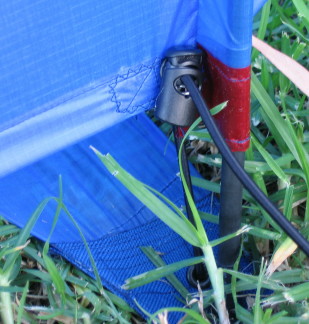
The poles should be assembled gently: the carbon fibre can be bruised or damaged if you let the ends snap together too often. This caution also applies to the common aluminium poles, but to a slightly lesser extent. This is a minor worry in practice. On the other hand, you should also make sure the poles are fully inserted into the joiners: I have seen many broken aluminium poles in bushwalking shops where the ends have been split open when this was not done. With the bends I have to thread the poles into the sleeve just a little more carefully, but the silnylon is so slippery this is very easy to do. I just negotiate each bend with a little care: no hard shoves! Provided the pole sleeve is not too tight this turns out to be a non-event in practice. The pole feet poke or socket into eyelets in the ground flaps sticking out from the corners of the groundsheet, and the fly is tensioned down with a bungee cord at each end. This is shown to the right. With the pole threaded through its sleeve, I usually put the pole foot at the far end into its socket and put that socket on the ground. It helps if my wife keeps it on the ground while I do up the near side, but it isn't essential. I then gently pull the sleeve down the pole on the near side and put the pole foot into its socket. I find this is easier to do if I slacken off the bungee cords at the sockets before I put the poles in the sleeves. Then I do the same at the other pole. Finally, I tighten the bungee cords, peg out the guy lines, and adjust their tensions. I make sure the end guys do have a fairly good tension in them.
The final check I do is to walk around the tent making sure each pole end seems to be level with the seam in the roof: not pushed too far towards the front or rear of the tent. I also check that the ground flaps seem to be lightly tensioned outwards. Basically, I make sure that the poles are where they should be according to the design. But this can be done very quickly, and you don't have to be all that 'precise'. I do it because there have been times when one pole end has been caught on the ground way out of position. Then I check the angles of the bungee cords at the ends of the tent, that they seem to be aligned with the tent and not skewed off to one side. Then I know the tent is 'right'. OK, I'm fussy.
A trap for the unwary is that some very light strings used for guy ropes either stretch after a while or slip. When nylon gets cold and wet it stretches, so you may need to retighten your guys late in the evening. On the other hand, some of the higher strength strings of Spectra and Dyneema are so hard and slippery they don't hold knots very well. So conventional guy rope hitches are not reliable on them.
Pulling the tent down is the reverse of the above. I always do up the inner and outer doors first to leave the tent ready to pitch the next time. We usually give the tent a careful shake before rolling it up to remove water from the roof and mulch, sand or soil from the groundsheet. There are actually two schools of thought about packing a tent: one school rolls the tent up neatly while the other just stuffs the tent into its bag. In either case, try to not crumple the whipper snipper cord too violently, but it will be rolled up of course. I usually roll the tent up neatly, but I am not sure it matters.
Of late I have abandoned the idea of a conventional stuff sack for the tent. it was just too difficult getting a wet tent into it in the rain. I made a flat open duffle bag arrangement which is very easy to fill with a rolled-up tent. A draw cord around the edge pulls the opening together. This works great in mud and snow.
© Roger Caffin 6/6/2002, 20/06/2009